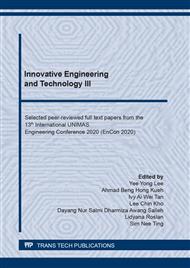[1]
A. Luque, S. Hegedus, Handbook of photovoltaic science and engineering, John Wiley & Sons, (2011).
Google Scholar
[2]
M. Zeman, R. A. C. M. M. v. Swaaij, J. W. Metselaar, R. E. I. Schropp, Optical modeling of a-Si:H solar cells with rough interfaces: Effect of back contact and interface roughness, Journal of Applied Physics 88 (2000) 6436-6443.
DOI: 10.1063/1.1324690
Google Scholar
[3]
H. Tan, R. Santbergen, A. H. M. Smets, M. Zeman, Plasmonic Light Trapping in Thin-film Silicon Solar Cells with Improved Self-Assembled Silver Nanoparticles, Nano Letters 12 (2012) 4070-4076.
DOI: 10.1021/nl301521z
Google Scholar
[4]
T. M. Razykov, C. S. Ferekides, D. Morel, E. Stefanakos, H. S. Ullal, H. M. Upadhyaya, Solar photovoltaic electricity: Current status and future prospects, Solar Energy 85 (2011) 1580-1608.
DOI: 10.1016/j.solener.2010.12.002
Google Scholar
[5]
D. Vasileska, S. M. Goodnick, G. Klimeck, Computational Electronics: semiclassical and quantum device modeling and simulation, CRC Press, (2017).
DOI: 10.1201/b13776
Google Scholar
[6]
H. Zhu, A. K. Kalkan, J. Hou, S. J. Fonash, Applications of AMPS-1D for solar cell simulation, AIP Conference Proceedings 462 (1999) 309-314.
DOI: 10.1063/1.57978
Google Scholar
[7]
M. Asaduzzaman, M. B. Hosen, M. K. Ali, A. N. Bahar, Non-Toxic Buffer Layers in Flexible Cu(In,Ga)Se2 Photovoltaic Cell Applications with Optimized Absorber Thickness, International Journal of Photoenergy 2017 (2017) 8.
DOI: 10.1155/2017/4561208
Google Scholar
[8]
H. Kida, M. Itoh, S. Fukazawa, T. Ohta, and K. Yamamoto, A Device Modeling of Amorphous Silicon Based Tandem Solar Cells, Japanese Journal of Applied Physics 28 (1989) L1499-L1501.
DOI: 10.1143/jjap.28.l1499
Google Scholar
[9]
M. Zeman, J. A. Willemen, L. L. A. Vosteen, G. Tao, J. W. Metselaar, Computer modelling of current matching in a-Si : H/a-Si : H tandem solar cells on textured TCO substrates, Solar Energy Materials and Solar Cells, 46 (1997) 81-99.
DOI: 10.1016/s0927-0248(96)00094-3
Google Scholar
[10]
X. Chen, B. Jia, J. K. Saha, B. Cai, N. Stokes, Q. Qiao, Y. Wang, Z. Shi, M. Gu, Broadband Enhancement in Thin-Film Amorphous Silicon Solar Cells Enabled by Nucleated Silver Nanoparticles, Nano Letters, 12 (2012) 2187-2192.
DOI: 10.1021/nl203463z
Google Scholar
[11]
J. Springer, A. Poruba, M. Vanecek, Improved three-dimensional optical model for thin-film silicon solar cells, Journal of Applied Physics, 96 (2004) 5329-5337.
DOI: 10.1063/1.1784555
Google Scholar
[12]
J. Krc, Optical modeling and simulation of thin-film photovoltaic devices, CRC Press, (2016).
Google Scholar
[13]
C. F. Bohren, D. R. Huffman, Absorption and scattering of light by small particles, John Wiley & Sons, (2008).
Google Scholar
[14]
D. M. Caughey, R. E. Thomas, Carrier mobilities in silicon empirically related to doping and field, Proceedings of the IEEE, 55 (1967) 2192-2193.
DOI: 10.1109/proc.1967.6123
Google Scholar
[15]
N. V. Voshchinnikov, G. Videen, T. Henning, Effective medium theories for irregular fluffy structures: aggregation of small particles, Applied Optics vol. 46 (2007) 4065-4072.
DOI: 10.1364/ao.46.004065
Google Scholar
[16]
D. Vasileska, Computational Electronics, https://nanohub.org/resources/1500#series.
Google Scholar
[17]
R. Quay, C. Moglestue, V. Palankovski, S. Selberherr, A temperature dependent model for the saturation velocity in semiconductor materials, Materials Science in Semiconductor Processing 3 (2000) 149-155.
DOI: 10.1016/s1369-8001(00)00015-9
Google Scholar
[18]
N. D. Arora, J. R. Hauser, D. J. Roulston, Electron and hole mobilities in silicon as a function of concentration and temperature, IEEE Transactions on Electron Devices 29 (1982) 292-295.
DOI: 10.1109/t-ed.1982.20698
Google Scholar
[19]
B. T. Wong, P. M. Mengüç, Thermal Transport for Applications in Micro/Nanomachining, Springer Science & Business Media, (2008).
Google Scholar


